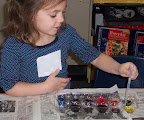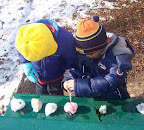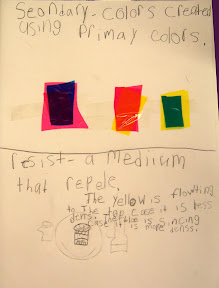Mixing colors combines art and science in one activity
By Peggy Ashbrook
Posted on 2009-03-29
 Colored acetate sheets make new colors as they overlap. Give children just the primary colors–a dark pink, a blue, and a yellow—and they can create orange, green, purple, and deep grays and browns without any instruction. Like scientists they can share their results with others and repeat the process to see if the results are the same. (The acetate is often sold at this time of year in craft and party stores as wrapping paper.)
Colored acetate sheets make new colors as they overlap. Give children just the primary colors–a dark pink, a blue, and a yellow—and they can create orange, green, purple, and deep grays and browns without any instruction. Like scientists they can share their results with others and repeat the process to see if the results are the same. (The acetate is often sold at this time of year in craft and party stores as wrapping paper.)

Young children will spend more time than one would expect mixing colored water in a clear container using droppers (pipettes). Highly diluted liquid watercolors create jewel-like colors. The children focus their attention and carefully move small amounts of colored water from one compartment in a clear egg carton to another, creating new colors.
 They get just as excited about the grey as they do the greens and purples. They did it and they are so proud! For those schools where snow falls, applying small amounts of colored water to snowballs is another way to mix colors.
They get just as excited about the grey as they do the greens and purples. They did it and they are so proud! For those schools where snow falls, applying small amounts of colored water to snowballs is another way to mix colors.
Colors can be recorded by dropping onto a paper towel, although they will be much lighter when dry.


Color mixing results can be part of an on-going science notebook kept all year.
Young scientist-artists enjoy learning that artists used to mix their own pigments and that some recipes do not last well with time (read about Leonardo da Vinci’s paint medium choices for “The Last Supper”). Ask the children to share their “recipe” and explain how you can get that color too.
Peggy
Disclaimer: The views expressed in this blog post are those of the author(s) and do not necessarily reflect the official position of the National Science Teaching Association (NSTA).


